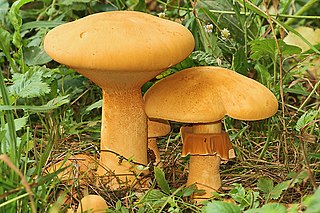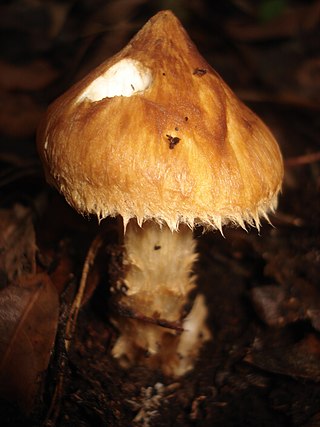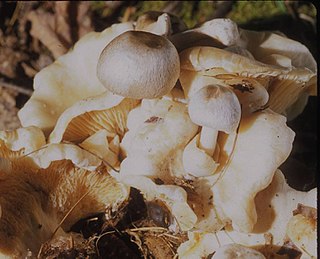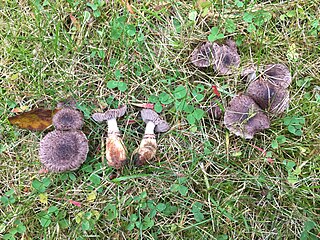
Secotioid fungi are an intermediate growth form between mushroom-like hymenomycetes and closed bag-shaped gasteromycetes, where an evolutionary process of gasteromycetation has started but not run to completion. Secotioid fungi may or may not have opening caps, but in any case they often lack the vertical geotropic orientation of the hymenophore needed to allow the spores to be dispersed by wind, and the basidiospores are not forcibly discharged or otherwise prevented from being dispersed —note—some mycologists do not consider a species to be secotioid unless it has lost ballistospory.

Amanita muscaria, commonly known as the fly agaric or fly amanita, is a basidiomycete of the genus Amanita. It is a large white-gilled, white-spotted, and usually red mushroom.

The Agaricales are an order of fungi in the division Basidiomycota. As originally conceived, the order contained all the agarics, but subsequent research has shown that not all agarics are closely related and some belong in other orders, such as the Russulales and Boletales. Conversely, DNA research has also shown that many non-agarics, including some of the clavarioid fungi and gasteroid fungi belong within the Agaricales. The order has 46 extant families, more than 400 genera, and over 25,000 described species, along with six extinct genera known only from the fossil record. Species in the Agaricales range from the familiar Agaricus bisporus and the deadly Amanita virosa to the coral-like Clavaria zollingeri and bracket-like Fistulina hepatica.

The Boletales are an order of Agaricomycetes containing over 1300 species with a diverse array of fruiting body types. The boletes are the best known members of this group, and until recently, the Boletales were thought to only contain boletes. The Boletales are now known to contain distinct groups of agarics, puffballs, and other fruiting-body types.

The Hygrophoraceae are a family of fungi in the order Agaricales. Originally conceived as containing white-spored, thick-gilled agarics, including Hygrophorus and Hygrocybe species, DNA evidence has extended the limits of the family, so it now contains not only agarics, but also basidiolichens and corticioid fungi. Species are thus diverse and are variously ectomycorrhizal, lichenized, associated with mosses, or saprotrophic. The family contains 34 genera and over 1000 species. None is of any great economic importance, though fruit bodies of some Hygrocybe and Hygrophorus species are considered edible and may be collected for sale in local markets.

The Hymenogastraceae is a family of fungi in the order Agaricales with both agaric and false-truffle shaped fruitbodies. Formerly, prior to molecular analyses, the family was restricted to the false-truffle genera. The mushroom genus Psilocybe in the Hymenogastraceae is now restricted to the hallucinogenic species while nonhallucinogenic former species are largely in the genus Deconica classified in the Strophariaceae.

Leucopholiota is a genus of fungi in the family Squamanitaceae. Basidiocarps are agarics (gilled mushrooms}. Two species are currently known, both from north temperate areas: Leucopholiota decorosa and Leucopholiota lignicola.

Phaeolepiota is a genus of fungi in the family Squamanitaceae. The genus is monotypic, containing the single species Phaeolepiota aurea. Commonly known as golden bootleg or golden cap, P. aurea is an agaric found throughout North America and Eurasia – often in groups and next to nettles. Recent molecular phylogenetics research however, shows that Phaeolepiota is closely related to and may need to be merged into the genus Cystoderma.

Squamanita is a genus of parasitic fungi in the family Squamanitaceae. Basidiocarps superficially resemble normal agarics but emerge from parasitized fruit bodies of deformed host agarics.
Miracula is a genus of parasitic protists that parasite diatoms, containing the type species Miracula helgolandica. More recently, the species Miracula moenusica from the river Main in Frankfurt am Main, Miracula islandica from a shore in the north of Iceland, Miracula einbuarlaekurica from a streamlet in the north of Iceland, and Miracula blauvikensis from the shore at the research station Blávík in the east fjords of Iceland were added to the genus. It is the only genus in the family Miraculaceae, of uncertain taxonomic position within the Oomycetes. They're one of the most basal lineages in the phylogeny of Oomycetes.
Dissoderma paradoxum, which has the recommended English name of powdercap strangler in the UK, is a species of fungus in the family Squamanitaceae. It is a parasitic fungus that grows on the fruit bodies of another fungus, Cystoderma amianthinum. It takes over the host and replaces the cap and gills with its own but retains the original stipe, creating in effect a hybrid between the two. The species was first described as Cystoderma paradoxum by American mycologists Alexander H. Smith and Rolf Singer in 1948, based on specimens collected in Mount Hood National Forest in Oregon. Cornelis Bas transferred the species to the genus Squamanita in 1965. Recent molecular research, based on cladistic analysis of DNA sequences, has however shown that the species does not belong in Squamanita sensu stricto but in the related genus Dissoderma. The species occurs in both North America and Europe.

Volvariella surrecta, commonly known as the piggyback rosegill, is an agaric fungus in the family Pluteaceae. Although rare, the species is widely distributed, having been reported from Asia, North America, Northern Africa, Europe, and New Zealand. The fungus grows as a parasite on the fruit bodies of other gilled mushrooms, usually Clitocybe nebularis. V. surrecta mushrooms have white or greyish silky-hairy caps up to 8 cm (3.1 in) in diameter, and white gills that turns pink in maturity. The stipe, also white, is up to 9 cm (3.5 in) long, and has a sack-like volva at its base.

Arrhenia lobata is a species of agaric fungus in the family Hygrophoraceae. It is found in the Iberian Peninsula and central Europe, and North America. It associates with mosses and may have a parasitic relationship with them.
Squamanita citricolor is a species of fungus in the family Squamanitaceae. Found in the Democratic Republic of the Congo, it was first described as new to science in 1998. Fruit bodies of the fungus have a yellow cap, and a whitish to yellowish stipe originating from a yellowish, deeply rooting basal bulb in the shape of an inverted cone. Microscopically, the fungus features very thick-walled spindle-shaped (fusiform) pleurocystidia and cheilocystidia.
Squamanita contortipes is a small mushroom species in the family Squamanitaceae, formerly in the Tricholomataceae. It was originally described in 1957 by American mycologist Alexander H. Smith and Daniel Elliot Stuntz as a member of Cystoderma. Paul Heinemann and David Thoen transferred it to the genus Squamanita in 1973. Discovery of an unusual fruiting of this species where three fruitbodies grew on one, still fertile host pileus which was a species of Galerina proved that Squamanita was a mycoparasitic genus. Photos of this fruiting were published in 1994 and immediately republished and highlighted in 1995 in Nature magazine where the original discovery article was featured. The species proved to be the Rosetta Stone for deciphering the parasite from the host in graft-like fruitings. Normally, S. contortipes only forms one fruitbody on each parasitized host and the host normally fails to remain fertile and does not form its own pileus.
Cystoderma granuliferum is a species of fungus in the family Squamanitaceae. It is found in the Amazonian region of Ecuador, where it grows on the rotting wood of dicotyledons. The fungus was described as new to science in 1999 by mycologists Cornelis Bas and Thomas Læssøe. Molecular research, based on cladistic analysis of DNA sequences, has shown that it belongs in the genus Cystoderma.

Dissoderma is a genus of parasitic fungi in the family Squamanitaceae. Basidiocarps superficially resemble normal agarics but emerge from parasitized fruit bodies of deformed host agarics.

Dissoderma odoratum is a species of fungi in the family Squamanitaceae. It is a distinctly strong-smelling species with small, purple sporocarps. The fungus parasites in the sporocarps of the veiled hebeloma, which are deformed by the parasitic fungus. Dissoderma odoratum is mostly found in Europe but has also been found from the United States. The fungus is a rare species that is classified as endangered in several European countries.

















